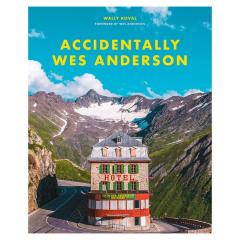Accidentally Wes Anderson

Accidentally Wes Anderson is a coffee table photography book inspired by the cinematic style of American movie director, Wes Anderson. Those who are familiar with Anderson’s movies, The Grand Budapest Hotel, The Royal Tenenbaums, The Darjeeling Limited, etc., will instantly recognize the similarity of these chosen images in the book with the director’s very distinctive cinematographic visuals.
The author of the book, Wally Koval, is a serious devotee of Anderson’s work and is part of a very committed cult following. In tribute to Anderson, he set up an Instagram account in 2017 of the same title and it features photographs submitted by the Accidental Wes Anderson Community (AWA), made up of professional and amateur photographers. AWA members have captured various locations from across the globe in the pictorial likeness of Anderson and in turn, Koval is the curator and publisher of these submitted photos.
As with the Spanish director, Pedro Almodóvar, Wes Anderson is one of the most visually identifiable directors working in cinema today. Both directors share a love of using bold, vibrant colour in their cinematography (though Anderson relies heavily on a pastel palette too) and both apply a centre-framing technique as part of their quirky, directorial approach. If readers are a fan of either director, this book will appeal to them.
The photos in this publication have closely imitated Anderson’s unique imagery, creating the most meticulously constructed photos, and using, to great effect, saturated colouring and centered compositions. This methodology has created quite a strong focal point and a sense of symmetry and perpendicularity to the images. They are all in keeping with Anderson’s visuals of putting things in the middle of a shot.
Though I was expecting a book to be jam-packed with images, there is accompanying text, giving some weird and wonderful stories of the locations and building façades within the photos. There are three images featured from Ireland: the National Library of Ireland, the diving board on the promenade in Salthill, Galway and 7, Thomas Court, The Liberties. Again, there is corresponding anecdotes about these Irish landmarks. The location images are not all about exotic scenes, the book also documents landmarks from local neighbourhoods but with a charming Wes Anderson aesthetic vibe going on.
The art deco influence of the photographs blend vintage and retro, with both exterior and interior shots, and has a certain European flair and nostalgia. The images are taken across all seven continents but mostly, feature North American and Eastern European locations as they seem best suited to Anderson’s signature visual style.
The reader/viewer will find the photos in this book to be a true visual treat, and by default, an unofficial travel guide. Similarly when buying a music album on the strength of one song, one might mistakenly book a holiday on the strength of one of Wes Anderson’s lookalike images. Such is the power of his creative brand and singular style.












